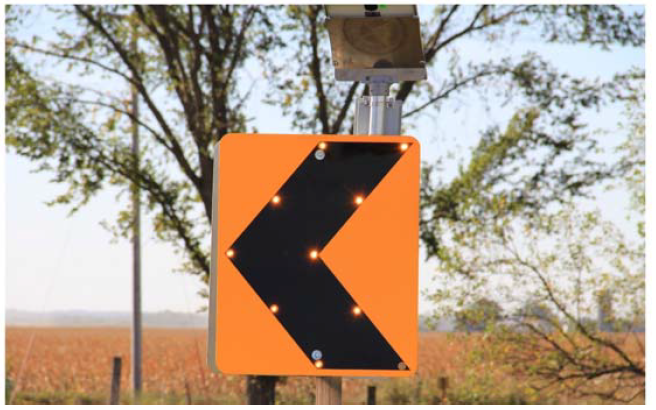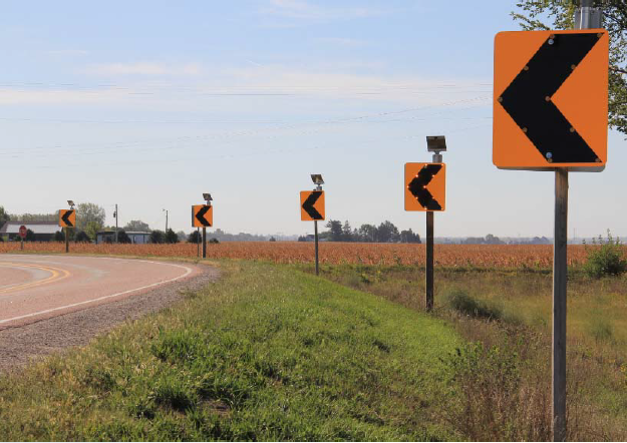A Sequential Dynamic Lighting Curve Warning System utilizes LED-enhanced solar or electric powered signs and wireless controllers with ultra-low power radar. The system flashes a series of chevron-shaped signs in sequential order to warn and guide drivers through the upcoming horizontal curve, similar to airplane approach lighting patterns. The network connecting the signs is constantly communicating and providing a synchronization pulse through the connection to ensure the signs are flashing in proper order through the curve. This countermeasure can be particularly useful in helping motorists navigate sharp curves in various weather conditions, including fog, rain, and snow, as well as driving at night and through work zones.
What Are The Benefits?
This safety countermeasure helps drivers realize they need to slow down because of a curve and helps guide them through it. It has many benefits including improved advisory speed adherence, fewer run-off-the-road crashes, and a decrease in the severity of crashes.
Innovation in Motion
A pilot project was successfully launched in PennDOT District 1 on the ramp from Interstate 86 to Interstate 90 in Erie County in September 2019. This ramp had a history of single-vehicle, run-off-the-road crashes that resulted in many large trucks striking the guiderail and traveling down an embankment.
 PennDOT’s District 11 plans to install three different system types at three locations in 2020. One location is the Interstate 79 "S-bends," a series of tight curves where numerous rollover and run-off-the-road crashes have occurred. A rollover detection system was installed in early 2020 to help prevent some of the issues; the flashing chevrons will help reinforce that system. The district expects this electrically-powered system to run constantly.
PennDOT’s District 11 plans to install three different system types at three locations in 2020. One location is the Interstate 79 "S-bends," a series of tight curves where numerous rollover and run-off-the-road crashes have occurred. A rollover detection system was installed in early 2020 to help prevent some of the issues; the flashing chevrons will help reinforce that system. The district expects this electrically-powered system to run constantly.
District 10 installed
solar-powered sequential LED chevron signage on Interstate 80, just east of the Brookville interchange, and on U.S. 119 in Indiana County at the Wake Robin curve. Both locations had a substantial crash history and use of the static chevron and curve warning signs didn't lessen the number of crashes on and around these locations.
District 11 also plans to test a solar-powered system, which is beneficial at locations where electric power sources are not readily available. They will also test a curve warning system that will work in coordination with an existing speed minder system, which detects and records motorist’s speeds.
 The Pennsylvania Turnpike Commission has also successfully implemented this safety countermeasure to help reduce crashes at the curve near east bound Mile Post 123. This specific curve was identified in a crash segment analysis indicating that the crash rate at this curve was higher than other locations along the Turnpike. The sequential chevrons were installed to supplement the static chevrons and a flashing curve warning sign already placed at the curve. Since the installation of the sequential chevrons, there has been a reduction in the frequency of crashes.
The Pennsylvania Turnpike Commission has also successfully implemented this safety countermeasure to help reduce crashes at the curve near east bound Mile Post 123. This specific curve was identified in a crash segment analysis indicating that the crash rate at this curve was higher than other locations along the Turnpike. The sequential chevrons were installed to supplement the static chevrons and a flashing curve warning sign already placed at the curve. Since the installation of the sequential chevrons, there has been a reduction in the frequency of crashes.
DID YOU KNOW...
• According to PennDOT data, 40 percent of crash fatalities in 2018 and 35 percent of crash fatalities in 2017 were due to single vehicle, run-off-the-road crashes
• In 2019, 42 percent of crash fatalities were due to single vehicle, run-off-the-road crashes
More Information
For more information about this innovation, contact the
STIC Management Team.